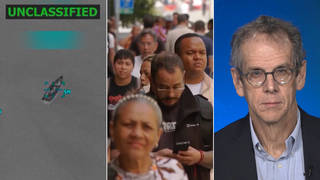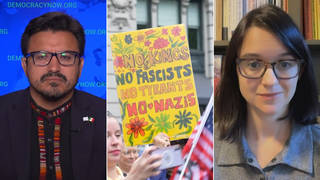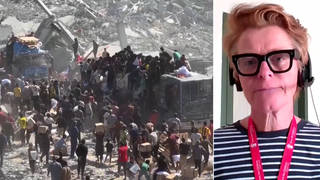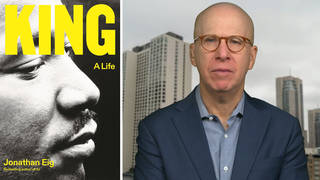
Topics
Guests
- Nancy Buirskidirector and producer of the documentary The Rape of Recy Taylor.
- Crystal FeimsterYale historian and author of Southern Horrors: Women and the Politics of Rape and Lynching.
A new film looks at the 1944 gang rape of Recy Taylor, a 24-year-old black mother and sharecropper. Following the rape, she refused to be silenced and spoke up with help from the NAACP’s chief rape investigator Rosa Parks. When Parks went to interview Taylor, the local sheriff kept driving by the house and eventually burst in, threatening Parks with arrest if she didn’t leave town. Parks left and then launched the Alabama Committee for Equal Justice for Mrs. Recy Taylor, triggering a movement to seek justice 11 years before Parks became a civil rights hero for refusing to give up her bus seat to a white man, launching the Montgomery bus boycott. We speak with the film’s director, Nancy Buirski, and with Yale historian Crystal Feimster, author of “Southern Horrors: Women and the Politics of Rape and Lynching.”
Transcript
JUAN GONZÁLEZ: We turn now to a new film that looks at what happened in 1944 when a 24-year-old black mother and sharecropper was gang-raped in Alabama and refused to be silenced. This is a clip from the trailer of the documentary, The Rape of Recy Taylor.
RECY TAYLOR: I saw the car pull up behind me. Some white boys. I mean, they didn’t say nothing about what they were going to do to me. They put me in the car, then went blindfold me. I was begging them to leave me alone, don’t shoot me. I’ve got to go home to see about my baby. They wouldn’t let me go. I can’t help but tell the truth, what they done to me.
JUAN GONZÁLEZ: That was Recy Taylor herself, describing what happened the night six white boys abducted and brutally raped her as she walked home from a church service in Abbeville, Alabama. After the men raped Taylor, they left her on the side of a deserted road, where she was found by her father.
This is another clip from the film The Rape of Recy Taylor. This starts with her brother, Robert Corbitt, followed by her sister, Alma Daniels. They explain what happened to Recy Taylor the night she was raped.
ALMA DANIELS: What they did to her—and, you know, my sister didn’t have any more kids after that and never got pregnant after that. And they didn’t only just have sex with her. After they got through mutilating her, they played in her body.
ROBERT CORBITT: I don’t know if she was feeling pain or what. That was—that was after they kept her about four or five hours down in the woods. Seven guys, one night. They said they wanted her to act just like she was going to be with her husband.
AMY GOODMAN: The boys had warned Taylor repeatedly that they would kill her if she spoke out. But despite the threats, Recy Taylor identified her rapists, though few women spoke up, in fear for their lives. In fact, the rape of black women by white men was so common in Jim Crow South that the NAACP had a chief rape investigator. That person was none other than Rosa Parks. When Rosa Parks went to interview Recy Taylor—we’re talking 11 years before the Montgomery bus boycott—the local sheriff kept driving by the house and eventually burst in, threatening Rosa Parks with arrest if she didn’t leave town. Parks left and then launched the Alabama Committee for Equal Justice for Mrs. Recy Taylor, triggering a movement to seek justice—again, 11 years before Rosa Parks became that civil rights hero for refusing to give up her bus seat to a white man, launching the Montgomery bus boycott.
For more, we’re joined by Nancy Buirski, the producer and director of The Rape of Recy Taylor, and we’re joined by Professor Crystal Feimster. She’s an associate professor of African American studies at Yale University, interviewed in the film, and author of the book Southern Horrors: Women and the Politics of Rape and Lynching.
We welcome you both to Democracy Now! Nancy Buirski, let’s begin with you, why you took on this film. What an amazing moment for it to be shown, in the midst of the #MeToo movement. And, again, amplify this story of Recy Taylor and what ultimately happened to her.
NANCY BUIRSKI: You know, Recy Taylor is amazingly courageous for speaking up. As you mentioned, very few women did that. They were afraid for their lives. Their families would be threatened, and their friends’ livelihoods would be threatened. So, what she did was extraordinary. And, you know, we made this film before this #MeToo movement. We had no idea that this would all erupt. But now, as I look back on it, I realize that Recy Taylor’s story is the first link in a long chain. It may—not even the first link. It really goes back to slavery. But it is a very pivotal link in a chain that goes right through the civil rights movement, right up through Black Power, and obviously is resolved today.
AMY GOODMAN: And Recy Taylor, what happened? What was—what were the investigations? You have Rosa Parks, this amazing—
NANCY BUIRSKI: Right.
AMY GOODMAN: —story of Rosa Parks going to Abbeville. This is what motivated Rosa Parks, what propelled her.
NANCY BUIRSKI: You know, they had a grand jury investigation soon after the rape. I think that took place in October. The rape took place in September. She did not get any justice. You know, she identified her rapists, but, to no one’s surprise, these guys were not indicted. And that’s when Rosa Parks steps in and says, “We have to put more pressure on the governor. We have to get some kind of justice.” So she comes to Abbeville. She interviews Recy Taylor. She gets kicked out of the—Abbeville by the sheriff. She comes back. She interviews her again. And she takes her up to Montgomery, where she forms this Committee for Equal Justice for Mrs. Recy Taylor. And what this—what this does, basically, is it triggers the black newspapers to write about this story. And black newspapers were the only newspapers that were writing these stories in those days. The white newspapers, they didn’t suppress it, they just ignored it. It wasn’t important.
JUAN GONZÁLEZ: Well, the film highlights the role of the black press, that it played in documenting and publicizing what happened to Recy Taylor. This clip begins with journalist and activist Esther Cooper Jackson, followed by Danielle McGuire. McGuire is the author of At the Dark End of the Street, the book that inspired the film.
ESTHER COOPER JACKSON: The only place we really were able to publish articles about Recy and others was through The Chicago Defender, the Pittsburgh Courier, the Amsterdam News, the Baltimore, etc.—through the black press.
DANIELLE McGUIRE: It’s part of the kind of infrastructure of injustice, where the white press ignores these kinds of crimes, and then—and then there’s no record of them happening, which gives judges and juries plausible deniability of any knowledge, and maybe this is a rumor. You know, it’s not even in the newspaper. And that’s why it’s so important that the black press publishes these stories.
JUAN GONZÁLEZ: That was historian Danielle McGuire. We’re also joined by Crystal Feimster, associate professor of African American studies at Yale University, author of Southern Horrors: Women and the Politics of Rape and Lynching. Professor Feimster, could you talk about the role of the African-American press, papers like The Chicago Defender, the Pittsburgh Courier, the Baltimore Afro-American, that were really exposing a lot of what was happening in the Jim Crow South, because they were in the North and were able to do that?
CRYSTAL FEIMSTER: Right. The African-American press, of course, played a huge role in exposing white violence, particularly against African-American women and men throughout the Jim Crow South. Most often those stories were—stories about rape were told through the stories about lynching, right? And that’s what my work has focused on, that sort of longer history. And we can’t think about the press and not think about Frederick Douglass’s newspaper or Ida B. Wells’s anti-lynching campaign and how black folks have mobilized the press. I mean, we can think about, in this current moment, how folks mobilize social media as an outlet, but, yes, African Americans in the black press were key, not just to Recy’s case, but to all the work that black organizations, like the NAACP, were doing in the early 20th century. So, yes.
AMY GOODMAN: Can you talk about what happened to her, what happened to Recy Taylor, the astonishing fearlessness? After she’s raped, and they tell her, “We will kill you unless you promise not to say a word,” she immediately spoke out. And talk about the investigations that that led to over the decades. This story haunted Alabama for decades. And then what happened in 2011 in the Alabama state Legislature?
CRYSTAL FEIMSTER: Right. So, much of what we know about Recy Taylor and her case comes from Danielle McGuire’s research for The Dark End of the Street and also from what Robert Corbitt tells us, what Recy continues to tell us and continues to testify about even today. And we get to hear her voice in Nancy’s beautiful film.
But we know that Recy comes home. We know that she tells her husband, her father what happens to her. She goes before two grand juries—right?—to testify and identify the young boys who gang-raped her that night. As we know, Esther Cooper comes in and does an investigation. There’s a letter-writing campaign, right? There are unions that organize. As we’ve already mentioned, the black press picks up the story. And it’s there that the story moves. It becomes not just a national story, but an international story, right? And the campaign for Recy continues, right?
But, ultimately, after those two grand juries refused to indict on behalf of Recy’s case, as Danielle McGuire’s work reveals, is that the movement moves on, in some ways. And that’s not to say that they’re no longer invested in—investigating rape cases of black women, but the cases keep coming. They keep—there are new cases every day of black women being assaulted by white men. And so they take on new cases, and they try to push those cases forward.
And Recy, you know, goes back to her life and her family and continues to live, but has a hard life. We know that her daughter dies in a tragic car accident. We know that her marriage falls apart. But she continues to live, to live her life, and to speak about—speak out about what happened to her. She never shies away from that story or backs down. And I think she says it eloquently in the film, that she had to speak the truth about what happened to her. And just because there wasn’t justice in the case, she wasn’t silenced. And many women who spoke up after her refused to be silenced. I think there is a long tradition of black women speaking to sexual assault and sexual violence, even when justice isn’t an option.
JUAN GONZÁLEZ: Well, Nancy Buirski, in the film, you also include a letter from Rosa Parks, where she talks about an attempted rape against her by someone in 1931, much earlier.
NANCY BUIRSKI: Correct. She is a nanny in a white home. And, of course, this happened frequently to nannies, where, you know, the caretaker—I mean, she was the caretaker. So she is approached by a person in the neighborhood, and she persuades him not to rape her. This is what’s extraordinary. She actually talks him out of it. And that letter reflects her ideology and what she basically says to him.
AMY GOODMAN: Let’s go to that letter.
NANCY BUIRSKI: OK.
AMY GOODMAN: Rosa Parks herself. The man, whom she called “Mr. Charlie,” had come into the house where she worked while the family was out for the evening. He has a drink, puts his hand on her waist, propositions her. This is the film.
ROSA PARKS: [read by Cynthia Erivo] I knew that no matter what happened, I would never yield to this white man’s bestiality. I was ready and willing to die. But give any consent, never.
AMY GOODMAN: So that’s Parks, who goes on to write, “If he wanted to kill me and rape a dead body, he was welcome but he would have to kill me first.”
NANCY BUIRSKI: You know, it’s extraordinary when you think that even she didn’t speak up immediately. This letter is written years after that incident took place. And she used it as an essay, to convey what had happened to her to many more people, and, ideally, empower other people to speak up finally. But that’s an example, to me, of how difficult it was to speak up in those days. One of the reasons that we know so little about this entire, what I consider an epic history is that the few women who spoke up, if they did speak up, it was often not reported. We didn’t find out about it.
You know, when lynching took place in the Deep South, that was meant to be visible. It was a tool of terrorism, and it was meant to tell people where their place was—black—African Americans. But women weren’t treated the same way. They were raped also as a tool of terrorism, but it was also a rite of passage for a lot of these guys. And, I mean, they had been brought up with a mentality that you have a right to do this, you have a right to take advantage of a black woman’s body. And so, not only did the women not speak up, but neither did their husbands, because if their husbands fought back, they’d be lynched.
JUAN GONZÁLEZ: I want to go to another—
CRYSTAL FEIMSTER: I also think—
JUAN GONZÁLEZ: Oh, I’m sorry, go ahead.
CRYSTAL FEIMSTER: No, I was going to say that I also think that, you know, what Rosa Parks’ letter reveals and, I think, what the film reveals and the sort of longer history on sexual violence against black women reveals is that while black women may not have had a public platform in which to speak out and to have an audience, that black women resisted sexual assault. And the way that they spoke out often was in their behavior, in the way that they fought back. And we see that resilience and that outspokenness in Rosa Parks’ words to Mr. Charlie, right?
And I think that that’s where historians find a wealth of sources—right?—around how black women protested, because they didn’t have traditional outlets—the white press, right?—or an audience that was favorable or interested in sexual assault and violence against black women. They had to find alternative ways to fight back and to speak back. And sometimes that was through the way that they resisted the violence. And sometimes it was taking those cases to the local sheriff, and oftentime with little or no result, right?
So, I think there may be a way to kind of think about the sort of spectrum in which—in ways that women do speak out, even though it doesn’t sort of fit how we think women should be speaking out in kind of this #MeToo moment, because I think we all know that these things happen—right?—and that there is a silence, but there is a way that that silence often speaks volumes. So I think it’s important. And I think that both Danielle and Nancy’s work kind of reveals the kind of diverse ways in which women speak out in protest.
JUAN GONZÁLEZ: And, Nancy, what kind of pushback did you get when you went to the Alabama town where this all occurred to try to interview people about it, who were—people who were still alive?
NANCY BUIRSKI: We tried to interview many more people who end up in the—than who you see in the film. There were white businessmen that we wanted to speak with, and they shut us out, basically. You see in the film a few relatives of the rapists, who speak to us. And frankly, I was surprised they did. I think that, on some level, they’re in some kind of denial, because they use euphemisms to talk about what their brothers had done. So I’m not sure they quite—either they don’t accept what they did, or they don’t how to talk about it.
But in terms of the African Americans, they were more than happy to speak. And I just want to draw attention to the incredible courage of Robert Corbitt, the brother of Recy Taylor, who has made it his mission to expose this story even today.
AMY GOODMAN: And what happened in Alabama Legislature in 2011?
NANCY BUIRSKI: They issue an apology. And—
AMY GOODMAN: That’s it?
NANCY BUIRSKI: That’s it. And, you know, the Corbitt family, Corbitt and Taylors, they believe that’s a little too little, too late, but they will accept it. I mean, there’s a tremendous amount of dignity in that family. And they will continue speaking of this. They will continue sending this message that this kind of thing should not happen. One of the things that’s really important to know is that no one felt any shame. Recy Taylor felt no shame. There was no reason to. She knew there was a legacy to this kind of behavior.
AMY GOODMAN: And she is alive today, Recy Taylor in Alabama.
NANCY BUIRSKI: And she is alive today. She’s still here.
AMY GOODMAN: I want to thank Nancy Buirski, director and producer of The Rape of Recy Taylor, and Crystal Feimster, associate professor of African American studies at Yale University, author of Southern Horrors: Women and the Politics of Rape and Lynching.
And we’ll end again on the headline that came out this week: Tarana Burke, the woman who founded the #MeToo movement, will be ringing in the new year in New York. She’ll be there at midnight as a woman who has spoken out.












Media Options